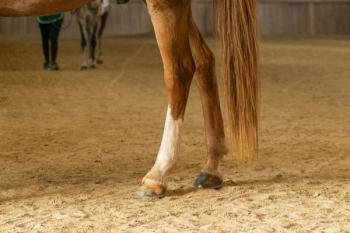
Juvenile pubic symphysiodesis--a simple, affordable surgical solution to canine hip dysplasia (Proceedings)
Juvenile pubic symphysiodesis (JPS) is a minimally invasive, affordable, prophylactic procedure performed in immature dogs at risk for development of arthritis associated CHD.
Juvenile pubic symphysiodesis (JPS) is a minimally invasive, affordable, prophylactic procedure performed in immature dogs at risk for development of arthritis associated CHD. Essentially, JPS involves inducing premature closure of the pubic symphysis by thermal (electrocoagulation) necrosis. When pubic symphyseal growth is arrested, acetabular rotation occurs in such a way that femoral head coverage is improved. Dr. Kyle Mathews first described JPS in guinea pigs in 1996, and Dr. Scot Swainson first reported the procedure in dogs in 2000. Extensive research on JPS has been performed over the last 10 years by a group at the University of Wisconsin led by Dr. R Tass Dueland.
Surgical procedure
To perform JPS, the puppy is placed in dorsal recumbency and a short ventral midline incision is made directly over the pubis. In males, the penis and prepuce need to be retracted laterally. To expose the cartilage of the pubic symphysis the external obturator muscles on each side are elevated to the level of the obturator foramina, and visualization is maintained with Gelpi retractors.
The length of the pubic symphysis is about half to three quarters the length of the entire pelvic symphysis, and the caudal end of the pubis is approximately at the level of the caudal medial border of the obturator foramina. Symphysiodesis is accomplished by passing a sharp electrosurgery tip into the cartilage of the pubic symphysis and applying current. Studies have demonstrated that effective symphysiodesis is obtained by using a standard electrosurgery unit set to 40W, with thermal ablation spots set 3mm apart, and duration of application about 12 seconds. My personal experience has been that less power and time is probably required, certainly in the thinner area of the pubic symphysis. One study used a 30W dose for 10 sec at 3mm intervals, and this is likely adequate4.
One important aspect of JPS is to protect the rectum during application of current. The original description of the procedure recommended using a gloved (hopefully) finger to palpate for the electrosurgery tip rectally, but this has always struck me as somewhat crude. My personal recommendation is to make a finger-sized incision in the rectus abdominus attachment of the body wall on the cranial pubic brim, and use your finger to palpate for the electrosurgery tip in the pelvic canal. Reattachment of the body wall usually requires just a single large horizontal mattress suture. The needle is easily passed through the soft bone of the cranial pubis without the need for drilling holes. Closure is routine.
Because dogs that have received JPS are indistinguishable from dogs that have not had surgery, there is at least the potential for unethical breeding of these patients. Sterilization can be performed at the time of JPS, but data on early-age sterilization is still heavily debated. My present solution to this dilemma is to obtain permission to tattoo the dog with the letters "JPS".
Complications
Complications associated with the JPS procedure are extremely rare. Iatrogenic damage to abdominal viscera is possible, but has not been reported in the literature and is easily avoided with correct technique. Application of electrocautery for 12 seconds is quite long, and I have had one dog experience a small burn at the site of ground plate (a technician's dog, of course). This complication should be avoidable by ensuring a large area of contact and appropriate wetting of the plate. Studies indicate that the pelvic canal is slightly narrowed after JPS, but this has not been a clinical issue.
Clinical outcomes
Multiple studies have documented the benefits of JPS on both hip mechanics and clinical outcomes. Research by Dueland indicates that acetabular angle (a measure of acetabular coverage) increases, distraction index (a measure of laxity) decreases, and Norberg angle (a measure of femoral head seating) increases after JPS, with greater effects in younger dogs. Insignificant OA occurs in appropriately selected dogs with mild to moderate hip laxity7.
Patient selection
Patient age and severity of CHD at the time JPS is performed is critical to a successful outcome. Almost all beneficial effects are eliminated in dogs with a distraction index (DI)>0.7, or if the procedure is performed after about 24 weeks of age. Optimal age for JPS is probably around 12-16 weeks of age, so determining if a dog is an appropriate candidate can be difficult. Most dogs that are the best candidates do NOT have existing clinical signs, so some test for laxity is required. In general, a puppy that has a positive Ortolani sign and/or a DI of >0.4 is a reasonable candidate.
References
Mathews KG, Stover SM, Kass PH. Effect of pubic symphysiodesis on acetabular rotation and pelvic development in guinea pigs. Am J Vet Res 1996;57:1427-1433.
Swainson SW, Conzemius MG, Riedesel EA, et al. Effect of pubic symphysiodesis on pelvic development in the skeletally immature Greyhound. Vet Surg 2000;29:178-190.
Patricelli AJ, Dueland RT, Lu Y, et al. Canine pubic symphysiodesis: investigation of electrocautery dose response by histologic examination and temperature measurement. Vet Surg 2001;30:261-268.
Dueland RT, Adams WM, Fialkowski JP, Patricelli J, et.al. Effects of pubic symphysiodesis in dysplastic puppies. Vet Surg 2001;30:201-217.
Patricelli AJ, Dueland RT, Adams WM, et al. Juvenile pubic symphysiodesis in dysplastic puppies at 15 and 20 weeks of age. Vet Surg 2002;21:435-444.
Dueland RT, Adams WM, Patricelli AJ, et al. Canine hip dysplasia treated by juvenile pubic symphysiodesis. Part I: two year results of computed tomography and distraction index. Vet Comp Orthoped Traumatol 2010;23:306-317.
Dueland RT, Patricelli AJ, Adams WM, et al. Canine hip dysplasia treated by juvenile pubic symphysiodesis. Part I: two year clinical results. Vet Comp Orthoped Traumatol 2010;23:318-325.
Vezzoni A, Dravelli G, Vezzoni L, et al. Comparison of conservative management and juvenile pubic symphysiodesis in the early treatment of canine hip dysplasia. Vet Comp Orthoped Traumatol 2008:21:267-269.
Manley PA, Adams WM, Danielson KC, et al. Long-term outcome of juvenile pubic symphysiodesis and triple pelvic osteotomy in dogs with hip dysplasia. J Am Vet Med Assoc 2007;230:206-210.
Newsletter
From exam room tips to practice management insights, get trusted veterinary news delivered straight to your inbox—subscribe to dvm360.





